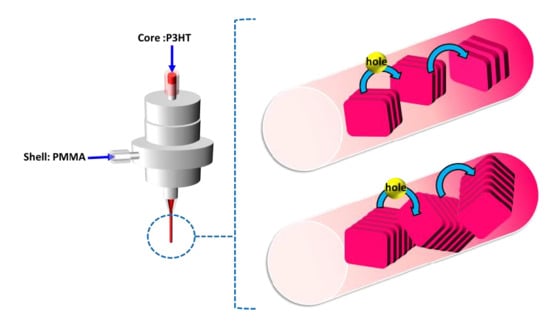Solvent Effects on Morphology and Electrical Properties of Poly(3-hexylthiophene) Electrospun Nanofibers
Abstract
:1. Introduction
2. Materials and Methods
3. Results
3.1. Solution Rheology
3.2. Morpholgy of P3HT Electrospun Nanofibers
3.3. Electrical Properties of P3HT Electrospun Nanofibers
3.4. Ductility Test of P3HT Electrospun Nanofibers
4. Conclusions
Supplementary Materials
Author Contributions
Funding
Conflicts of Interest
References
- Klauk, H. Organic Electronics: Materials, Manufacturing and Applications; Wiley-VCH Publishing: Weinheim, Germany, 2006. [Google Scholar]
- Bao, Z.; Locklin, J. Organic Field-Effect Transistors; CRC Press: New York, NY, USA, 2007. [Google Scholar]
- Surin, M.; Leclere, P.; Lazzaroni, R.; Yuen, J.D.; Wang, G.; Moses, D.; Heeger, A.J.; Cho, S.; Lee, K. Relationship between the microscopic morphology and the charge transport properties in poly(3-hexylthiophene) field-effect transistors. J. Appl. Phys. 2006, 100, 033712. [Google Scholar] [CrossRef]
- Chang, J.-F.; Sun, B.; Breiby, D.W.; Nielsen, M.M.; Solling, T.I.; Giles, M.; McCulloch, I.; Sirringhaus, H. Enhanced mobility of poly(3-hexylthiophene) transistors by spin-coating from high-boiling-point solvents. Chem. Mater. 2004, 16, 4772–4776. [Google Scholar] [CrossRef]
- Ma, W.; Yang, C.; Gong, X.; Lee, K.; Heeger, A.J. Thermally stable, efficient polymer solar cells with nanoscale control of the interpenetrating network morphology. Adv. Funct. Mater. 2005, 15, 1617–1622. [Google Scholar] [CrossRef]
- Yu, H.Z.; Peng, J.B. Annealed treatment effect in poly(3-hexylthiophene): Methanofullerene solar cells. Chin. Phys. Lett. 2008, 25, 1411. [Google Scholar]
- Wu, Z.; Petzold, A.; Henze, T.; Thurn-Albrecht, T.; Lohwasser, R.H.; Sommer, M.; Thelakkat, M. Temperature and molecular weight dependent hierarchical equilibrium structures in semiconducting poly(3-hexylthiophene). Macromolecules 2010, 43, 4646–4653. [Google Scholar] [CrossRef]
- Cho, S.; Lee, K.; Yuen, J.; Wang, G.M.; Moses, D.; Heeger, A.J.; Surin, M.; Lazzaroni, R. Thermal annealing-induced enhancement of the field-effect mobility of regioregular poly(3-hexylthiophene) films. J. Appl. Phys. 2006, 100, 114503. [Google Scholar] [CrossRef]
- Yi, H.-L.; Hua, C.-C. Peculiar aggregation features in poly(3-hexylthiophene)/chlorobenzene solutions. Macromolecules 2019, 52, 332–340. [Google Scholar] [CrossRef]
- Brown, P.J.; Sirringhaus, H.; Harrison, M.; Shkunov, M.; Friend, R.H. Optical spectroscopy of field-induced charge in self-organized high mobility poly(3-hexylthiophene). Phys. Rev. B 2001, 63, 125204. [Google Scholar] [CrossRef]
- Brinkmann, M.; Wittmann, J.-C. Orientation of regioregular poly(3-hexylthiophene) by directional solidification: A simple method to reveal the semicrystalline structure of a conjugated polymer. Adv. Mater. 2006, 18, 860–863. [Google Scholar] [CrossRef]
- Yang, H.; Shin, T.J.; Yang, L.; Cho, K.; Ryu, C.Y.; Bao, Z. Effect of mesoscale crystalline structure on the field-effect mobility of regioregular poly(3-hexyl thiophene) in thin-film transistors. Adv. Funct. Mater. 2005, 15, 671–676. [Google Scholar] [CrossRef]
- Root, S.E.; Savagatrup, S.; Printz, A.D.; Rodriquez, D.; Lipomi, D.J. Mechanical properties of organic semiconductors for stretchable, highly flexible, and mechanically robust electronics. Chem. Rev. 2017, 117, 6467–6499. [Google Scholar] [CrossRef] [PubMed]
- Ho, V.; Boudouris, B.W.; Segalman, R.A. Tuning polythiophene crystallization through systematic side chain functionalization. Macromolecules 2010, 43, 7895–7899. [Google Scholar] [CrossRef]
- Li, D.; Xia, Y. Direct fabrication of composite and ceramic hollow nanofibers by electrospinning. Nano Letters 2004, 4, 933–938. [Google Scholar] [CrossRef]
- Babel, A.; Li, D.; Xia, Y.N.; Jenekhe, S.A. Electrospun nanofibers of blends of conjugated polymers: Morphology, optical properties, and field-effect transistors. Macromolecules 2005, 38, 4705–4711. [Google Scholar] [CrossRef]
- Chen, J.-Y.; Wu, H.-C.; Chiu, Y.-C.; Lin, C.-J.; Tung, S.-H.; Chen, W.-C. Electrospun poly(3-hexylthiophene) nanofibers with highly extended and oriented chains through secondary electric field for high-performance field-effect transistors. Adv. Electron. Mater. 2015, 1, 1400028. [Google Scholar] [CrossRef]
- Chen, J.-Y.; Chiu, Y.-C.; Shih, C.-C.; Wu, W.-C.; Chen, W.-C. Electrospun nanofibers with dual plasmonic-enhanced luminescent solar concentrator effects for high-performance organic photovoltaic cells. J. Mater. Chem. A 2015, 3, 15039–15048. [Google Scholar] [CrossRef]
- Chen, J.-Y.; Wu, H.-C.; Chiu, Y.-C.; Chen, W.-C. Plasmon-enhanced polymer photovoltaic device performance using different patterned Ag/PVP electrospun nanofibers. Adv. Energy Mater. 2014, 4, 1301665. [Google Scholar] [CrossRef]
- Tsai, P.-C.; Chen, J.-Y.; Ercan, E.; Chueh, C.-C.; Tung, S.-H.; Chen, W.-C. Uniform luminous perovskite nanofibers with color-tunability and improved stability prepared by one-step core/shell electrospinning. Small 2018, 14, 1704379. [Google Scholar] [CrossRef]
- Kuo, C.-C.; Wang, C.-T.; Chen, W.-C. Highly-aligned electrospun luminescent nanofibers prepared from polyfluorene/PMMA blends: Fabrication, morphology, photophysical properties and sensory applications. Macromol. Mater. Eng. 2008, 293, 999–1008. [Google Scholar] [CrossRef]
- Li, D.; Wang, Y.; Xia, Y. Electrospinning of polymeric and ceramic nanofibers as uniaxially aligned arrays. Nano Lett. 2003, 3, 1167–1171. [Google Scholar] [CrossRef]
- Li, D.; Wang, Y.; Xia, Y. Electrospinning nanofibers as uniaxially aligned arrays and layer-by-layer stacked films. Adv. Mater. 2004, 16, 361–366. [Google Scholar] [CrossRef]
- Wen, Y.H.; Lin, P.C.; Hua, C.C.; Chen, S.A. Dynamic structure factor for large aggregate clusters with internal motions: A self-consistent light-scattering study on conjugated polymer solutions. J. Phys. Chem. B 2011, 115, 14369–14380. [Google Scholar] [CrossRef] [PubMed]
- Guo, R.H.; Hsu, C.H.; Hua, C.C.; Chen, S.A. Colloidal aggregate and gel incubated by amorphous conjugated polymer in hybrid-solvent medium. J. Phys. Chem. B 2015, 119, 3320–3331. [Google Scholar] [CrossRef] [PubMed]
- Yi, H.L.; Wu, C.H.; Wang, C.I.; Hua, C.C. Solvent-regulated mesoscale aggregation properties of dilute PBTTT-C14 solutions. Macromolecules 2017, 50, 5498–5509. [Google Scholar] [CrossRef]
- Liu, H.Q.; Reccius, C.H.; Craighead, H.G. Single electrospun regioregular poly(3-hexylthiophene) nanofiber field-effect transistor. Appl. Phys. Lett. 2005, 87, 253106. [Google Scholar] [CrossRef]
- Liu, J.; Shao, S.; Wang, H.; Zhao, K.; Xue, L.; Gao, X.; Xie, Z.; Han, Y. The mechanisms for introduction of n-dodecylthiol to modify the P3HT/PCBM morphology. Org. Electron. 2010, 11, 775–783. [Google Scholar] [CrossRef]
- Xue, L.; Yu, X.; Han, Y. Different structures and crystallinities of poly(3-hexylthiophene) films prepared from aged solutions. Colloids Surf. A 2011, 380, 334–340. [Google Scholar] [CrossRef]
- Berson, S.; De Bettignies, R.; Bailly, S.; Guillerez, S. Poly(3-hexylthiophene) Fibers for Photovoltaic Applications. Adv. Funct. Mater. 2007, 17, 1377–1384. [Google Scholar] [CrossRef]
- Zhang, J.; Wang, C.; Chen, W.; Wu, J.; Zhang, Q. Fabrication and physical properties of self-assembled ultralong polymer/small molecule hybrid microstructures. RSC Adv. 2015, 5, 25550–25554. [Google Scholar] [CrossRef]
- Hagler, T.W.; Pakbaz, K.; Voss, K.F.; Heeger, A.J. Enhanced order and electronic delocalization in conjugated polymers oriented by gel processing in polyethylene. Phys. Rev. B 1991, 44, 8652. [Google Scholar] [CrossRef]
- Nguyen, T.-Q.; Wu, J.; Doan, V.; Schwartz, B.J.; Tolbert, S.H. Control of energy transfer in oriented conjugated polymer-mesoporous silica composites. Science 2000, 288, 652–656. [Google Scholar] [CrossRef] [PubMed]
- Chen, J.-Y.; Kuo, C.-C.; Lai, C.-S.; Chen, W.-C.; Chen, H.-L. Manipulation on the morphology and electrical properties of aligned electrospun nanofibers of poly(3-hexylthiophene) for field-effect transistor applications. Macromolecules 2011, 44, 2883–2892. [Google Scholar] [CrossRef]


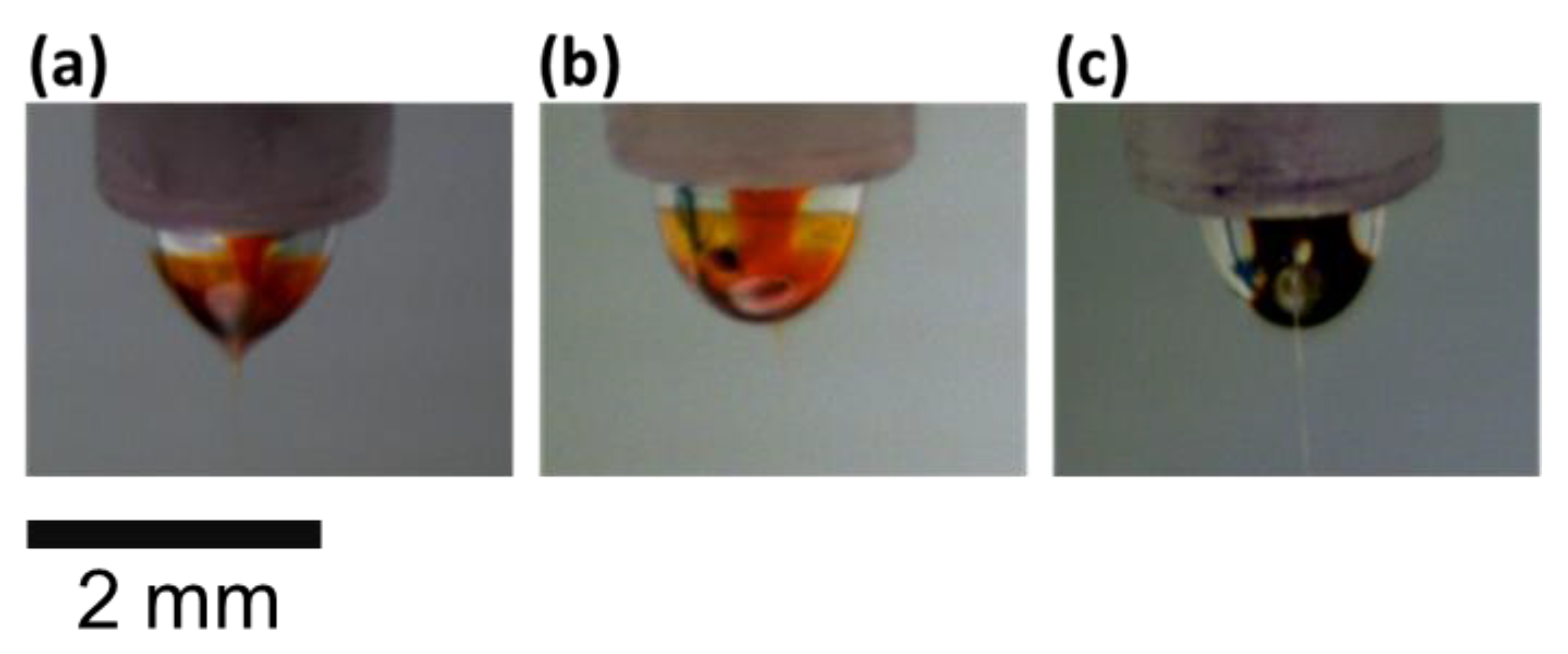

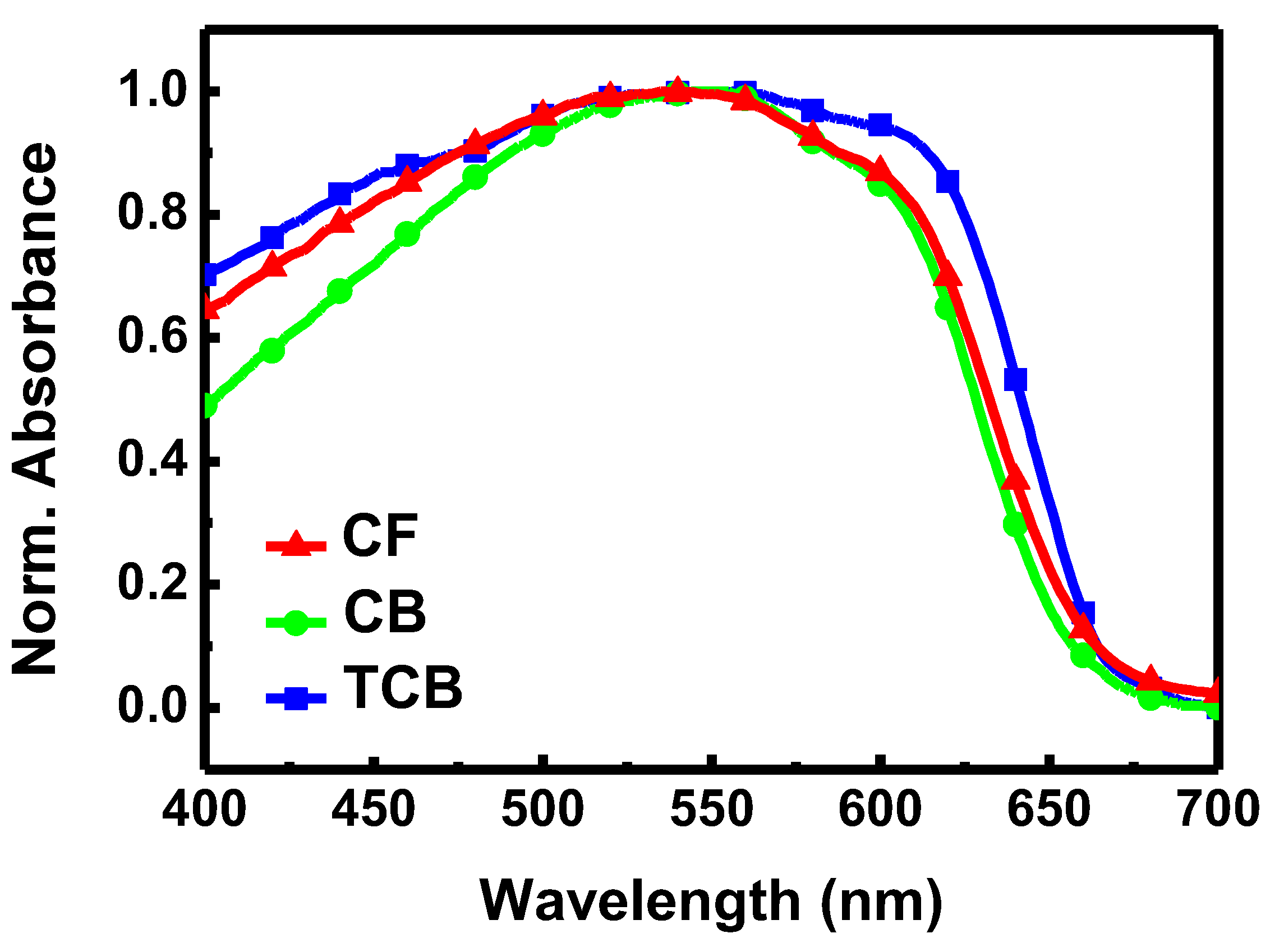

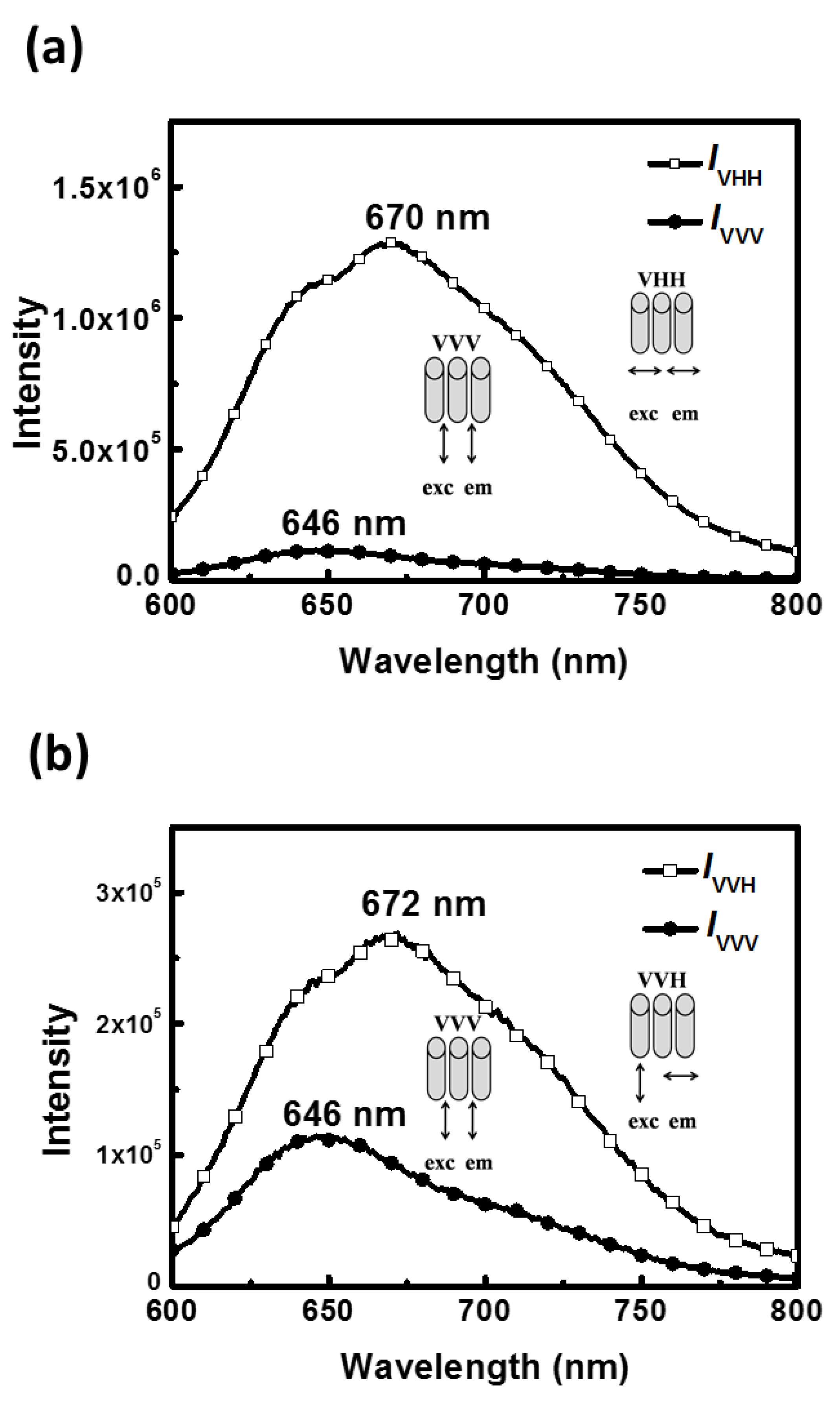

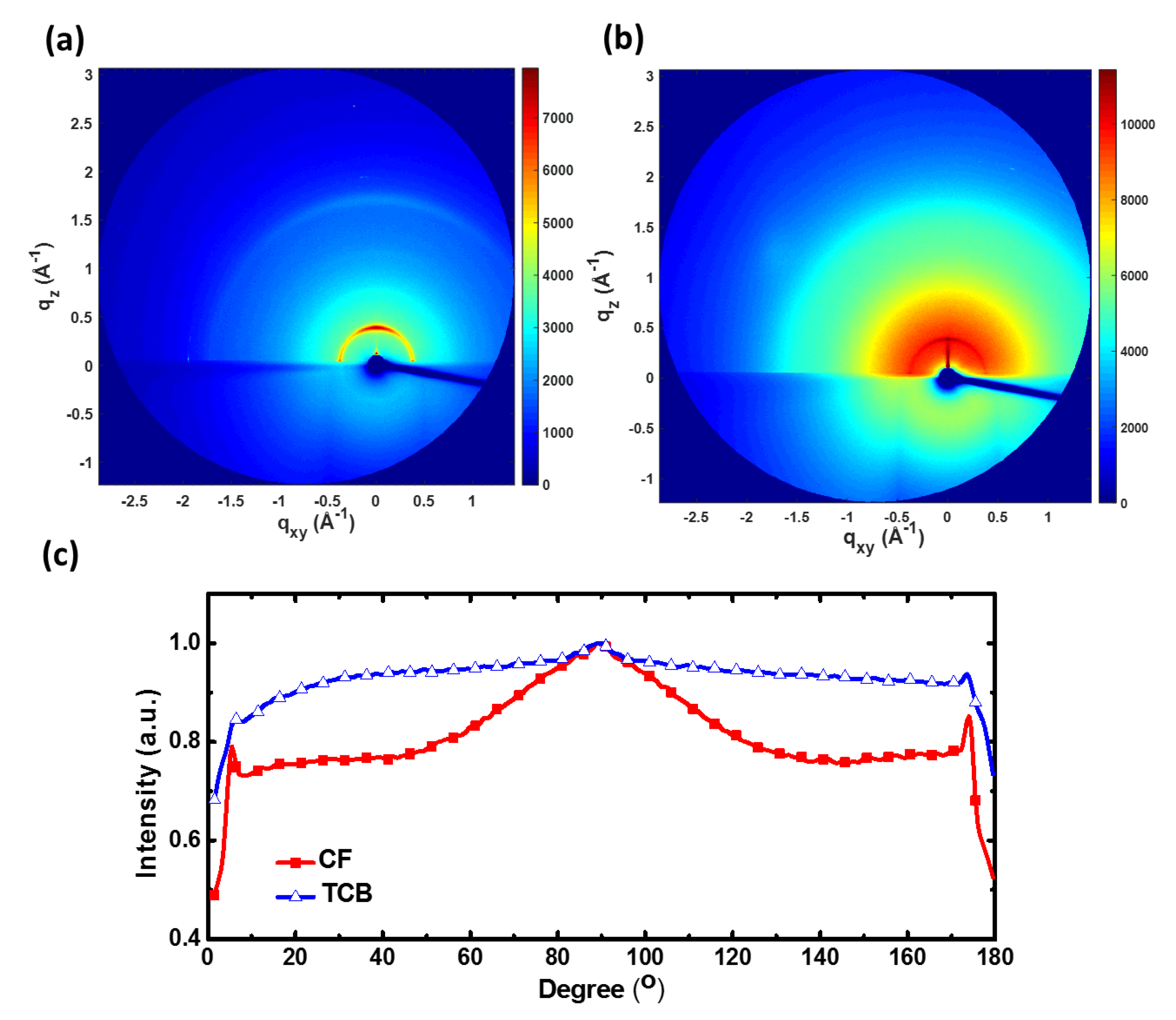

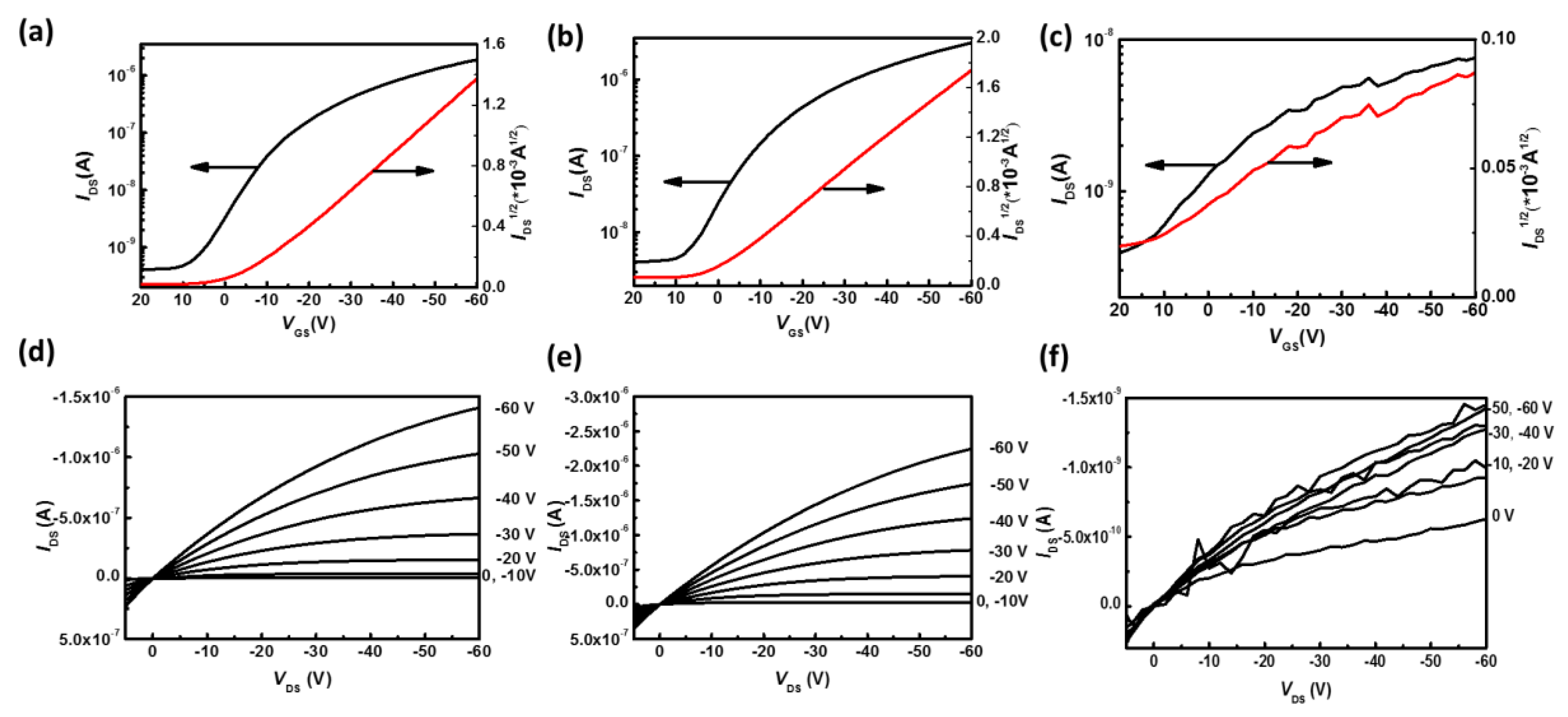

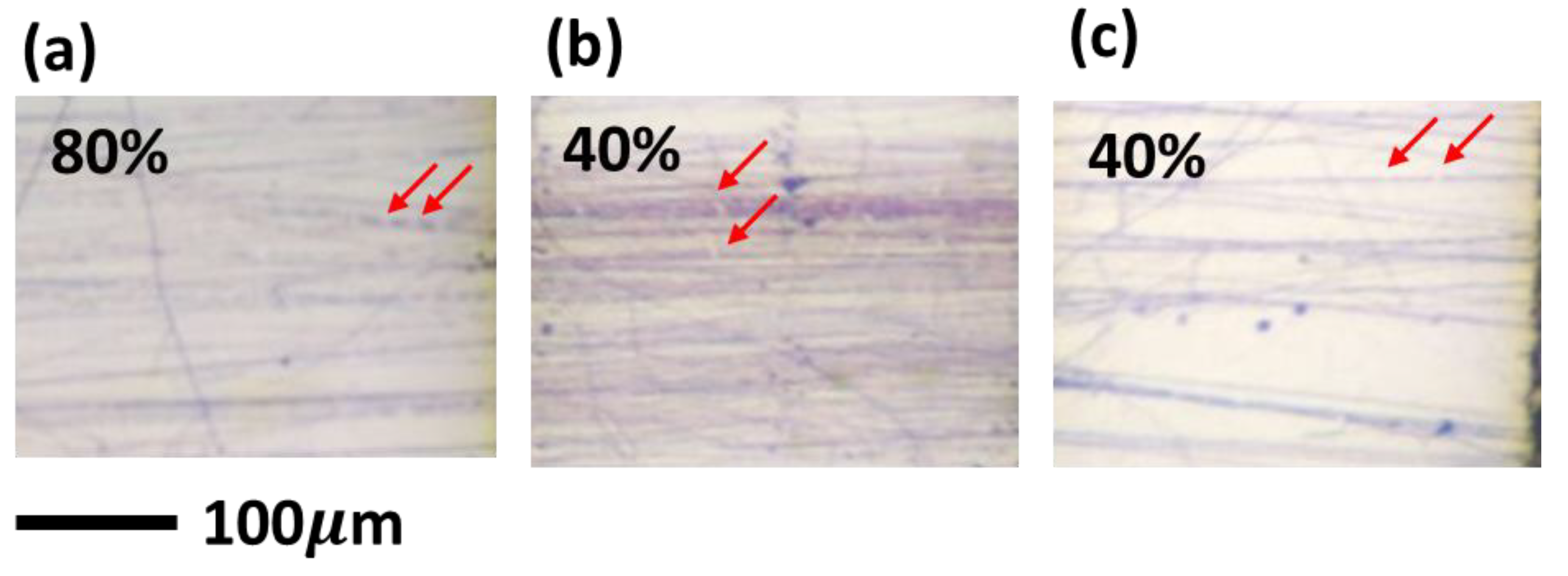
| Shell Flow Rate (ml·h−1) | Diameter (nm) | Mobility (cm2·V−1·s−1) | On Current (A) | Off Current (A) | On/Off (-) | VTH (V) |
|---|---|---|---|---|---|---|
| CF | 141 | 3.57 × 10−1 | 9.42 × 10−7 | 2.06 × 10−10 | 4.57 × 103 | −2.5 |
| CB | 168 | 1.78 × 10−1 | 4.33 × 10−7 | 5.74 × 10−10 | 7.54 × 102 | 3.3 |
| TCB | 265 | 1.48 × 10−4 | 1.09 × 10−9 | 5.60 × 10−11 | 1.94 × 101 | 40 |
© 2019 by the authors. Licensee MDPI, Basel, Switzerland. This article is an open access article distributed under the terms and conditions of the Creative Commons Attribution (CC BY) license (http://creativecommons.org/licenses/by/4.0/).
Share and Cite
Chen, J.-Y.; Su, C.-Y.; Hsu, C.-H.; Zhang, Y.-H.; Zhang, Q.-C.; Chang, C.-L.; Hua, C.-C.; Chen, W.-C. Solvent Effects on Morphology and Electrical Properties of Poly(3-hexylthiophene) Electrospun Nanofibers. Polymers 2019, 11, 1501. https://doi.org/10.3390/polym11091501
Chen J-Y, Su C-Y, Hsu C-H, Zhang Y-H, Zhang Q-C, Chang C-L, Hua C-C, Chen W-C. Solvent Effects on Morphology and Electrical Properties of Poly(3-hexylthiophene) Electrospun Nanofibers. Polymers. 2019; 11(9):1501. https://doi.org/10.3390/polym11091501
Chicago/Turabian StyleChen, Jung-Yao, Chien-You Su, Chau-Hsien Hsu, Yi-Hua Zhang, Qin-Cheng Zhang, Chia-Ling Chang, Chi-Chung Hua, and Wen-Chang Chen. 2019. "Solvent Effects on Morphology and Electrical Properties of Poly(3-hexylthiophene) Electrospun Nanofibers" Polymers 11, no. 9: 1501. https://doi.org/10.3390/polym11091501
APA StyleChen, J.-Y., Su, C.-Y., Hsu, C.-H., Zhang, Y.-H., Zhang, Q.-C., Chang, C.-L., Hua, C.-C., & Chen, W.-C. (2019). Solvent Effects on Morphology and Electrical Properties of Poly(3-hexylthiophene) Electrospun Nanofibers. Polymers, 11(9), 1501. https://doi.org/10.3390/polym11091501




